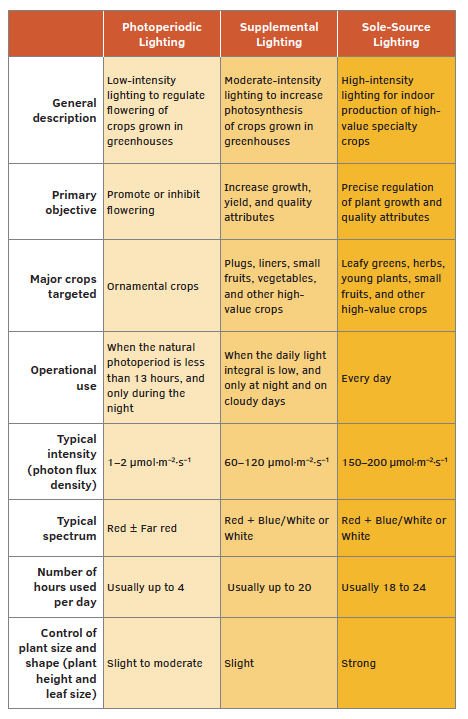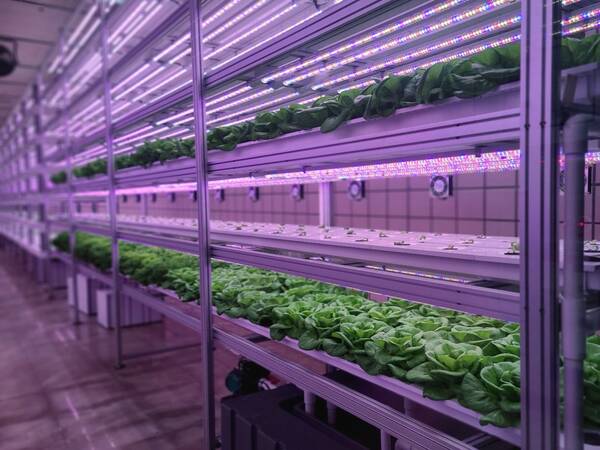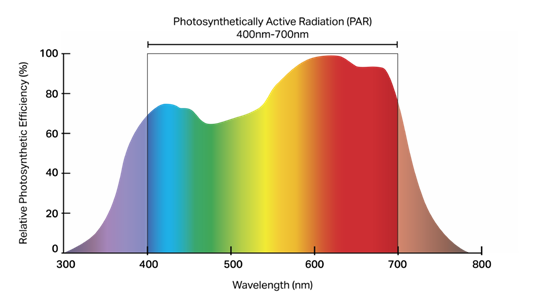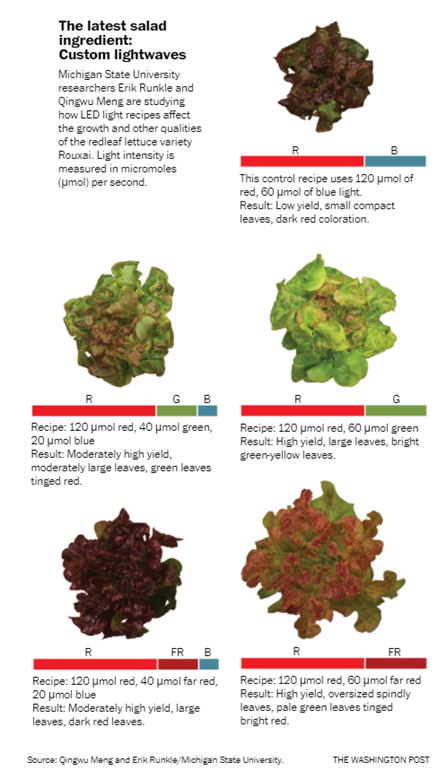LEDs are “Growing” in Horticultural Lighting Applications
In the roughly 12,000-year history of human agriculture, we can be sure it didn’t take long for humans to figure out that the amount of sunlight plants received had a direct impact on their growth and characteristics. And almost as soon electric light bulbs were invented in the 1860s, we started applying artificial light to help promote plant growth.1
Electrical lighting can fill the gap when there is a shortage of natural sunlight, for example, in a greenhouse on overcast days or during the winter. The right light fixtures can also enable indoor growing on a large scale. By supplying light energy, artificial illumination has opened the opportunity to grow crops under many conditions that were not previously possible.
Plants & Light
The essential process that makes earth habitable is, of course, photosynthesis. Plants (including algae and even some bacteria) take in water (H2O) and nutrients from the soil, absorb carbon dioxide (CO2) from the air, and then use energy (photons) from sunlight to convert these components into glucose, the essential sugar that sustains animal and human life. In the process, plants release oxygen (O2) back into the air, making it breathable.

Photosynthesis is the process by which plants use sunlight to produce glucose, the essential foundation of Earth’s food chain. (Image: National Geographic)
All light is not created equal, however, where plant growth is concerned. The visible spectrum of sunlight extends from deep violet at one end to red at the other (wavelengths of approximately 380 nm – 750 nm), and plants respond differently to light energy at various wavelengths. For decades, scientists have known that photosynthesis is optimized by red wavelengths, particularly around 660 nm. (Plants appear green to our eyes because they are most efficient at absorbing red light to use for photosynthesis, while reflecting mostly green light.) Plants also need light waves in the blue portion of the spectrum for root strength during germination, among other benefits. A barely visible range beyond red, known as far red, promotes larger leaves, branching, and flowering.2
Development of Horticultural Lighting
Research into agricultural light applications and plant response has continued alongside the development of various lighting technologies. From carbon-arc and incandescent light fixtures in the early 1900s, through the development of mercury and fluorescent lamps in the 1930s, all the way to today’s newest color-tunable LEDs, researchers, growers, and farmers alike have sought artificial sources that offered “sunlight-like” light—while also being affordable and energy efficient.
For the last several decades, a handful of technologies have become common in horticultural lighting applications. Called High Intensity Discharge (HID) lights, these fixtures offer higher lumen-per-watt intensity than earlier technologies. However, they also typically produce significant radiant heat, which does not contribute to photosynthesis, thus losing some efficiency. They also are not spectrally optimized for plant growth but are sufficient for multiple general applications. HID lights include mercury vapor, metal halide, ceramic metal halide, high pressure sodium and conversion bulbs.
Types of Horticultural Lighting Applications
Just as the nutrient, water, and light needs of various types of plants can differ, the specifics of each horticultural lighting application present a wide range of requirements. In broad terms, they can be categorized into photoperiodic lighting, supplemental lighting, and sole-source lighting situations.3
- Photoperiodic lighting. Many ornamental crops (such as those used in landscaping), regulate their flowering in response to cycles of daylight and nighttime. To encourage these plants to produce blooms when desired, photoperiodic lighting delivers low-intensity light to mimic light and dark cycles. It can encourage plant height, but does not promote photosynthesis, and thus does not increase plant growth.
- Supplemental lighting. Supplemental lighting is the delivery of moderate-intensity lighting at night and on cloudy days to increase plant growth and quality. For example, this technique is used for crops that require a lot of light, such as tomatoes, grown in greenhouses during the dark days of winter. High-pressure sodium lights are the most common source in these settings currently.
- Sole-source lighting. It is becoming more common to grow some crops in entirely indoor settings instead of greenhouses. For example, vertical farms are becoming increasingly popular for high-density agricultural operations. With artificial light as the only energy source, indoor growers are increasingly turning to LEDs, which now offer multiple benefits for horticultural applications.

Major lighting applications and characteristics used in the production of horticultural crops: photoperiodic lighting, supplemental lighting, and sole-source lighting. (Image Source)
LED Advancements Provide New Horticulture Lighting Capabilities
First invented in 1962, the earliest LEDs offered relatively low brightness and came in just one color: red. Since then, developers have been able to create LEDs in a rainbow of colors, including high-intensity white LEDs, using a variety of materials and methods. These newer LED products offer improved performance and efficiency and can have a wide range of spectral properties. They are enabling lighting schemes that are precisely tuned to different color spectra and that produce specific lighting attributes that enhance plant development. With the additional advantages of low power consumption, low thermal radiation, and durability, LEDs have started to become the horticultural lighting solution of choice for an increasing number of applications.
“LEDs have created a new technology platform for designers and researchers, resulting in an expanding range of options for growers. LED technology is driving important conversations around spectrum, energy efficiency and advanced control systems; features that can improve business and crop performance.”4 In fact, shipments of LED lights to growers worldwide are expected to increase at an average annual rate of 32% until 2027.5

The emerging practice of vertical farming stacks layers of plant trays indoors with LED lighting optimized to promote growth cycles. The technique maximizes crop yield for the available footprint in locations where land acreage is scarce or expensive, such as urban areas.
One of the exciting aspect of LEDs to horticulturalists is the ability to precisely control the hue and output—the correlated color temperature (CCT) and spectral power distribution (SPD)—of LEDs. A new agricultural discipline of light “recipes” has arisen: “With advances in LED technology, light recipes — determining the number of hours illuminated, the intensity of photons directed at plants and the mix of colors—can be finely tuned to each crop and even to each stage in a crop’s life.”6
Horticulture Light Recipes
Plant lighting is designed to optimize two key elements: photosynthesis rates and growth morphology (which means the growth of the structures of the plant such as stems, roots, leaves, and fruit). Both of these elements depend on the number of incident photons and the wavelengths of light that are absorbed by plant structures.
Human-oriented lighting sources are typically characterized by metrics such as lumens, illuminance, and luminous flux; these terms help quantify how the human eye perceives light emitted by a source. A different set of metrics is used to characterize horticultural lighting—how plants “perceive” and respond to light:
- Photosynthetically Active Radiation (PAR) – The wavelength range from 400 nm – 700 nm is called the PAR region. This is where photosynthesis occurs due to photon absorption. It is roughly equivalent to the range of light visible to the human eye, from approximately 380 nm – 750 nm.

The photosynthetically active region (PAR) of light is 400 nm – 700 nm. The PAR encompasses light waves that plants can use for photosynthesis. (Image: BIOS Lighting)
- Photosynthetic Photon Flux (PPF) – A measurement of the photosynthetically active photons emitted by a lighting system in the PAR wavelength region per second. Expressed in micromole per second (μmol/s), PPF is the plant equivalent of lumens (unit of luminous flux).
- Photon Efficacy – Electrical lighting systems work by converting energy (electricity) into photons (light). The efficiency of a horticultural lighting system is its photon efficacy, also referred to as PPF per Watt (PPF/W). It is expressed in micromole per Joule (μmol/J).
- Photosynthetic Photon Flux Density (PPFD) – The number of photosynthetically active photons that fall from a light source onto a given surface each second is the PPFD of that light. Expressed in micromoles per square meter per second (μmol/m2/s), PPFD is plant equivalent of lux (unit of illuminance).
- Day Light Integral (DLI) – This is a cumulative measure, counting the total number of photons (in the PAR) that reach a given surface during one day’s photoperiod. DLI is expressed in mol/m2/day. Determining the natural DLI of a greenhouse enables growers to calculate the amount of supplemental lighting needed for their desired crop yield.
Lighting recipes can be used to optimize activity during the four stages of plant growth: germination, vegetation, flowering, and fruiting. Different light wavelengths are absorbed by photopigments that control and promote growth. Different light recipes (wavelength and intensity combinations) can be used to achieve more biomass, shorten the growth cycle, enhance the taste or color of produce, and achieve optimal plant size.

Examples of how different light recipes can be used to alter plant growth and characteristics. (Image Source)
Measuring and Characterizing LEDs
Not only do different plants respond differently to various combinations of light, but each plant responds differently to light at various stages of its growth. Determining the correct lighting recipe for various crops to achieve specific outcomes in each unique setting can require custom calculations, considering spectral factors, beam angles, PPFD, DLI, and more. Each lighting component used—LED bulb or fixture—needs to be carefully considered for how it fits into the entire agricultural lighting plan.
To help both LED manufacturers and lighting design engineers measure and verify the output of lighting components, Radiant offers a range of integrated solutions for both R&D and production-line testing of intensity, illuminance, luminance, dominant wavelength, and CCT of various lighting sources. In R&D environments, compact goniometer systems—which measure light as a factor of angle—pair with imaging technology and application software to deliver fast, cost-effective, and comprehensive data for 3D light modeling.
Our systems enable lighting engineers to optimize their product designs and easily generate standard output files, including IES, EULUMDAT, or Radiant Source Model™ (RSM) formats. On the production line, our ProMetric® Imaging Colorimeter and Photometer solutions ensure product quality and consistency in real time, optimizing the efficiency of light measurement processes and increasing manufacturing yields.
With increasing adoption of LED lighting, trends for retrofitting agricultural light systems with LEDs, and the global horticultural lighting market anticipating a 21.4% CAGR to 2025,7 it’s safe to say that use of LEDs in agriculture applications will continue to “take root.”
CITATIONS
- Wheeler, R., “A Historical Background of Plant Lighting: An Introduction to the Workshop.” HortScience, Vol 23:7(1942-1943), December 2008. DOI: https://doi.org/10.21273/HORTSCI.43.7.1942
- Higgins, A., “Growing the future.” Washington Post, November 6, 2018.
- Runkle, E., “Horticultural Lighting Applications.” Greenhouse Product News, June, 2018.
- Alex Bodell, as quoted in Konjoian, P. and Bodell, A., “Horticulture’s History with Disruptive Technology; LED Lighting Takes Its Turn.” Greenhouse Product News, June 2019.
- Marshall, C. and Maxwell, K., LED Lighting for Horticultural Applications. Research Report by Navigant, Q1 2018
- Higgins, A., “Growing the future.” Washington Post, November 6, 2018.
- Horticultural Lighting Market…Global Forecast to 2025. Markets and Markets, 2020
Join Mailing List
Stay up to date on our latest products, blog content, and events.
Join our Mailing List
